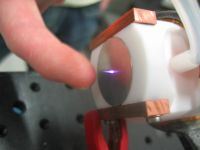Chemists from Zurich have developed a method for identifying pesticide residues in foodstuffs - a method that may also be important for other fields and which could enable routine quality control tests

As soon as consumers stand in front of the fruit and vegetable shelves in the supermarket, they have the last option to decide whether to buy regular apples or the kind grown organically.
If they choose the regular apples, they take the risk of digesting harmful toxins along with the important vitamins while eating the apples. To combat pests, live fruits and vegetables are sprayed with plant protection agents called pesticides. As a result, pesticide residues remain in the food eaten by consumers. Renato Zenobi, Professor of Analytical Chemistry in the Laboratory of Organic Chemistry, and his colleagues, have now developed a spectroscopic method for the rapid identification of pesticide residues in foodstuffs.
About a year ago, the group introduced a method for analytical testing of surfaces of any kind based on mass spectroscopy. The new method for identifying the pesticides uses a spectrometer called "Quadrupole Time-of-Flight Mass Spectrometer (QTOF-MS)", but how do the chemical compounds get to it?
Normally, the pesticides should be extracted from fruit and vegetable samples before testing them in the mass spectrometer. To avoid this time-consuming step, one of the researchers in the team built an Atmospheric Pressure Glow-Discharge source (APGD source), an electronic source that produces plasma, which is an ionized gas, at atmospheric pressure. When directed at a piece of fruit or vegetable peel, the plasma current causes compounds to detach from the surface of the peel. Afterwards, these compounds are flowed directly into the mass spectrometer, where the ions can be crushed with the help of a gas that collides with them, and thus the researchers are able to identify and characterize the chemical substances present in fruits, or any other food.
The researcher admits that, "despite the fact that this method is able to determine the chemical compounds more quickly and directly, it is still not suitable for accurate quantification of the identified residues."
He adds and says that currently the method can only be used for a preliminary examination - whether there are indeed any amounts of pesticide residues in fruits and vegetables, and in the next step the existing methods can be used to determine the exact amount of these residues that have already been identified.
Nevertheless, this new method for determining pesticide residues in fruits and vegetables is very promising. The researchers envision quality control tests as a moving film: samples of a selection of food products moving on one conveyor belt are tested in the spectrometer one after the other. The main researcher adds that the method is also promising for medical applications or in the field of MZP. It will be possible to identify traces of drugs or explosives on various surfaces or examine a person's sweat and exhalation to aid in the rapid diagnosis of various diseases.

3 תגובות
It needs to be corrected, not spectroscopically (which is the use of devices like IR and UV), but spectrometrically (devices like mass spectrometry)
There are quantities of pollutants in food and it is very carcinogenic so there is an excellent use for such a machine if the parts and food chains use it and save us from the amounts of chemicals they leave on our food and let us die with it
And when will it become a device for commercial distribution?